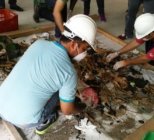Objects can become mouldy, distort, corrode, adhere and weaken in structure very quickly. This noticeably worsens approximately 48-72 hours after the incident.
Furthermore, prompt action can also prevent damage to collections. Swift containment reduces the volume of water that escapes, limiting the damage to mostly to boxes, rather than saturating the items themselves. General steps to control a water-damage incident may include:
Contain the leak promptly
Isolate electricity and investigate the leak source. If it is possible, isolate the source of the leak via stop-valves. If not, contact facilities or a sub-contractor to isolate the problem. Take steps to divert water to stop it leaking through your building. Use polythene sheets/tarpaulin or spill kits to minimise seepage of water.
Establish all areas of damage & risk assess the salvage operation
Conduct a thorough building check to identify all areas of leakage. Water will not necessarily pass through a building in a straight-line. It is particularly important to check the basement for signs of water-ingress. Wear appropriate personal protective equipment and establish methods for working safety.
Prevent further primary damage
Before dealing with wet material, ensure that nothing else will get wet, or wetter, from this point forward. Key steps will be to remove dry contents from wet boxes (the longer they are left in there the worse the water-penetration will become), cover shelving with polythene sheeting or move items out of the path of damage.
Consider your prioritisation
Take into account value, but also bear in mind some object are more susceptible to rapid deterioration/ secondary damage (paper, wood, textiles, paintings, sculpture, photos). Triaging may demand prompt intervention, despite other considerations of value.
Assess the quantity of damage
How much material is affected? Depending on the availability of space to spread / fan material out, some water-damaged incidents can be restored inhouse with a small quantity of blotting paper (see photograph to the left. Although single sheets of paper dry relatively quickly, the amount of space they use to dry can often be significant, precluding an inhouse restoration solution, in which case a contract a professional document restoration contractor such as Harwell. Retainer schemes exist for emergency support to the heritage sector. Other situations where external support may be required will include foul water, mould growth, archival collections to be kept in order, soiling.
If drying in-house
- Wear gloves. Clear floor first. Support items as you lift, with melinex, support boards, webbing/straps, removing original drawers, to minimise direct contact.
- Ensure you have a documentation system to track items and have set up a secure decant space and worked out a route there before moving items.
- Dry in a wind tunnel non-porous 3D items and hard-bound books. Create a wind tunnel by covering a table with polythene, weighting the polythene down, then placing items within the confined space on blotting paper, with a fan at either end. Dry through general (not targeted) air movement, porous items and 2D objects. Dry all composite wooden items together through careful reduction of humidity (rapid drying will result in cracking and splitting).
- Lay items on blotting paper, keeping flat. Increase the surface area where possible (e.g. fan books, place paintings on blocks). Items with a decorative surface (paintings, or photos) should be kept face up.
- Interleaving can be used to dry from within, but care taken not to distort shape.
- Ensure that the area where the damage occurred is thoroughly dried out so that unaffected items are not at risk of developing mould growth. Moisture can be trapped behind voids / under racking.
If engaging a professional document restoration contractor
Contact them as soon as possible – don’t delay. Stabilisation of objects within 48-72 hours after wetting can prevent mould growth and other forms of further deterioration which prolong the salvage and restoration process and increase costs. Textiles, paper and photographic material can be frozen to avert further damage, and then professional restoration. Other objects must all be immediately air-dried.
Dealing with fire and smoke damaged objects
Usually a high proportion of objects from stores will be restorable after a fire. In archives, charred records are likely to experience the worst damage around the edge, leaving critical information unaffected and restorable. Items which are on display / come into direct contact with the fire are more likely to be heavily damaged and will need expert treatment. The bulk of damage is likely to be from smoke particles, rather than charring however. The process for cleaning is to remove surface debris with specialist cleaning sponges. It is very labour intensive, with insurers often opting for professional restoration. Fire damage does not cause immediate secondary damage (as opposed to water), except for metals, plastics and electronic equipment where corrosion of components / discolouration occurs rapidly.
Back to top





